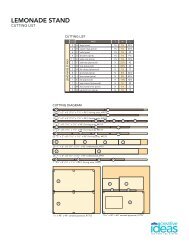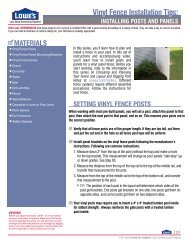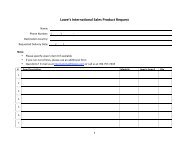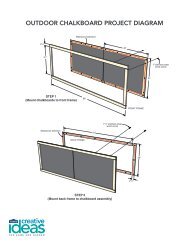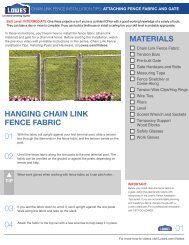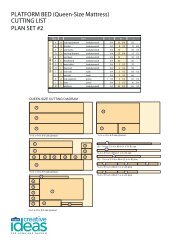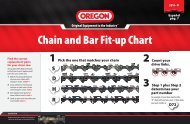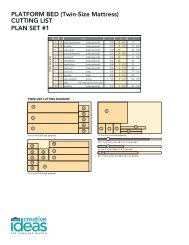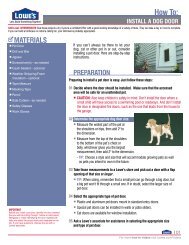You also want an ePaper? Increase the reach of your titles
YUMPU automatically turns print PDFs into web optimized ePapers that Google loves.
Frequently Asked QuestionsIs the base really that important?Yes! Just as you wouldn’t build a house without a foundation or leveling pad, the base and the buried portion of the block are crucial tothe integrity of your retaining wall. The base provides a level support for your wall, and the buried portion of the base course prevents thewall from moving, all of which are crucial to the longevity of your wall.What about leveling? If it’s a little “off,” nobody will notice, right?One of the key factors to building a long-lasting retaining wall is leveling. More than just making your wall appealing to the eye, levelingmaintains the batter (angle of the wall), which provides strength and prevents the wall from tipping forward. Leveling is not as difficult asyou may think. If you start with a level base and continue leveling each course as it is installed, building your wall will be much easier. Ifthe wall is left uneven at the base, the error will grow dramatically with each course that is added. It is much easier to make the correctionearly on than to try to correct it later.Okay, so I’ll level it. How do I do it right?To properly level your wall, you will need a carpenter’s level. Lay the level across your base, and check the level both front to back (tokeep your retaining wall from tipping backward or forward) and side to side (to make sure your wall is not going uphill or downhill). Startby leveling your base, and continue leveling as you lay each course of block. If you find an area that is not level, be sure to correct itbefore adding additional courses.FAQ’s | PREGUNTAS FRECUENTESWhat is so important about the drainage aggregate? What is it for?Water is one of the greatest forces your retaining wall will face. Protect yourself from future disappointments of wall failure by installingyour wall properly the first time, which means including the drainage aggregate behind your wall. All retaining walls will encounter theforce of water at some point, whether it is from heavy rains or some other unforeseen event. Adding proper drainage will prevent waterpressure from building up behind the wall and forcing it to collapse. In addition to building your wall properly, remember to keep gutterdownspouts pointed away from your retaining walls. Retaining walls and water pressure don’t mix!By following these key steps, you can build a retaining wall with confidence. Once it’s built, you’ll enjoy your new landscape for manyyears to come.Preguntas frecuentes¿Es tan importante la base?Sí. De la misma forma en que no construiría una casa sin cimientos o una base de nivelación, la base y la parte enterrada del bloque son cruciales parala integridad del muro de contención. La base proporciona un apoyo nivelado para el muro y la parte enterrada de la hilada base evita que el muro semueva. Ambas son cruciales para la durabilidad del muro.¿Qué ocurre con la nivelación? Si está un poco “desviado” nadie lo notará, ¿verdad?Uno de los factores fundamentales en la construcción de un muro de contención duradero es la nivelación. Más que sólo colaborar en el atractivo visualdel muro, la nivelación mantiene la inclinación (ángulo del muro), lo que proporciona resistencia y evita que el muro se caiga hacia delante. Nivelar no estan difícil como parece. Si comienza con una base nivelada y continúa nivelando cada hilada al instalarlas, la construcción del muro resultará mucho mássencilla. Si el muro queda irregular desde la base, el error aumentará considerablemente con cada hilada que agregue. Es mucho más sencillo hacer correccionesal principio que hacerlas después.Está bien, lo nivelaré. ¿Cómo lo hago correctamente?Para nivelar correctamente el muro, necesitará un nivel de carpintero. Coloque el nivel sobre la base y revise la nivelación de adelante hacia atrás (para que el murode contención no se incline hacia delante ni hacia atrás) y de lado a lado (para asegurarse de que el muro no suba ni baje). Comience nivelando la base y continúenivelando cada hilada de bloques a medida que las instala. Si encuentra un área que no esté nivelada, corríjala antes de agregar hiladas adicionales.¿Qué es lo importante del agregado para drenaje? ¿Para qué sirve?El agua es una de las mayores fuerzas que el muro de contención tendrá que soportar. Evítese decepciones futuras por daños en el muro instalándolocorrectamente desde el principio, lo que significa que se debe incluir agregado para drenaje detrás él. Todos los muros de contención tendrán que enfrentaren algún momento la fuerza del agua, ya sea a causa de lluvias fuertes o por algún otro suceso imprevisto. Si agrega el material para drenaje correcto,evitará que se acumule presión de agua detrás del muro, la cual podría hacerlo caer. Además de construir correctamente el muro, recuerde que lascanaletas y los bajantes pluviales deben estar dirigidos lejos de los muros de contención. ¡Los muros de contención y la presión de agua no van juntos!Si sigue estos pasos fundamentales podrá construir con confianza un muro de contención. Una vez construido, disfrutará de un nuevo jardín por variosaños venideros.41



